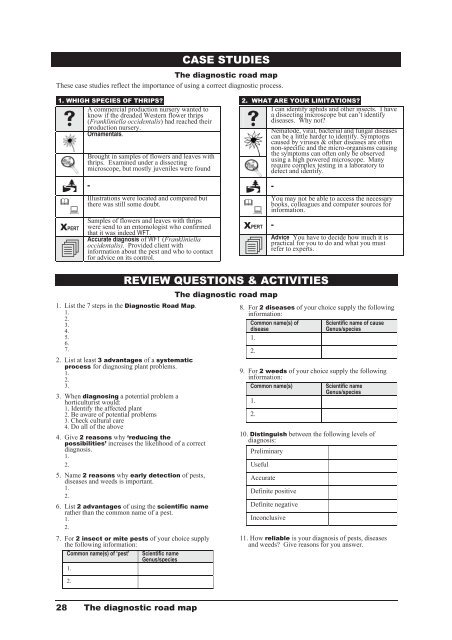PLANT PROTECTION 4
PLANT PROTECTION 4
PLANT PROTECTION 4
Create successful ePaper yourself
Turn your PDF publications into a flip-book with our unique Google optimized e-Paper software.
28 The diagnostic road map<br />
CASE STUDIES<br />
The diagnostic road map<br />
These case studies reflect the importance of using a correct diagnostic process.<br />
1. WHIGH SPECIES OF THRIPS?.<br />
<br />
A commercial production nursery wanted to<br />
know if the dreaded Western flower thrips<br />
(Frankliniella occidentalis) had reached their<br />
production nursery.<br />
Ornamentals.<br />
-<br />
<br />
<br />
XPERT<br />
<br />
Accurate<br />
Brought in samples of flowers and leaves with<br />
thrips. Examined under a dissecting<br />
microscope, but mostly juveniles were found<br />
Illustrations were located and compared but<br />
there was still some doubt.<br />
Samples of flowers and leaves with thrips<br />
were send to an entomologist who confirmed<br />
that it was indeed WFT.<br />
diagnosis of WFT (Frankliniella<br />
occidentalis). Provided client with<br />
information about the pest and who to contact<br />
for advice on its control.<br />
2. WHAT ARE YOUR LIMITATIONS?.<br />
<br />
I can identify aphids and other insects. I have<br />
a dissecting microscope but can’t identify<br />
diseases. Why not?<br />
Nematode, viral, bacterial and fungal diseases<br />
can be a little harder to identify. Symptoms<br />
caused by viruses & other diseases are often<br />
non-specific and the micro-organisms causing<br />
the symptoms can often only be observed<br />
using a high powered microscope. Many<br />
require complex testing in a laboratory to<br />
detect and identify.<br />
-<br />
You may not be able to access the necessary<br />
books, colleagues and computer sources for<br />
information.<br />
XPERT -<br />
<br />
Advice You have to decide how much it is<br />
practical for you to do and what you must<br />
refer to experts.<br />
REVIEW QUESTIONS & ACTIVITIES<br />
1. List the 7 steps in the Diagnostic Road Map.<br />
1.<br />
2.<br />
3.<br />
4.<br />
5.<br />
6.<br />
7.<br />
2. List at least 3 advantages of a systematic<br />
process for diagnosing plant problems.<br />
1.<br />
2.<br />
3.<br />
3. When diagnosing a potential problem a<br />
horticulturist would:<br />
1. Identify the affected plant<br />
2. Be aware of potential problems<br />
3. Check cultural care<br />
4. Do all of the above<br />
4. Give 2 reasons why ‘reducing the<br />
possibilities’ increases the likelihood of a correct<br />
diagnosis.<br />
1.<br />
2.<br />
5. Name 2 reasons why early detection of pests,<br />
diseases and weeds is important.<br />
1.<br />
2.<br />
6. List 2 advantages of using the scientific name<br />
rather than the common name of a pest.<br />
1.<br />
2.<br />
7. For 2 insect or mite pests of your choice supply<br />
the following information:<br />
Common name(s) of ‘pest’ Scientific name<br />
Genus/species<br />
1.<br />
2.<br />
The diagnostic road map<br />
8. For 2 diseases of your choice supply the following<br />
information:<br />
Common name(s) of<br />
disease<br />
1.<br />
2.<br />
Scientific name of cause<br />
Genus/species<br />
9. For 2 weeds of your choice supply the following<br />
information:<br />
Common name(s) Scientific name<br />
Genus/species<br />
1.<br />
2.<br />
10. Distinguish between the following levels of<br />
diagnosis:<br />
Preliminary<br />
Useful<br />
Accurate<br />
Definite positive<br />
Definite negative<br />
Inconclusive<br />
11. How reliable is your diagnosis of pests, diseases<br />
and weeds? Give reasons for you answer.






![[Compatibility Mode].pdf](https://img.yumpu.com/27318716/1/190x135/compatibility-modepdf.jpg?quality=85)










